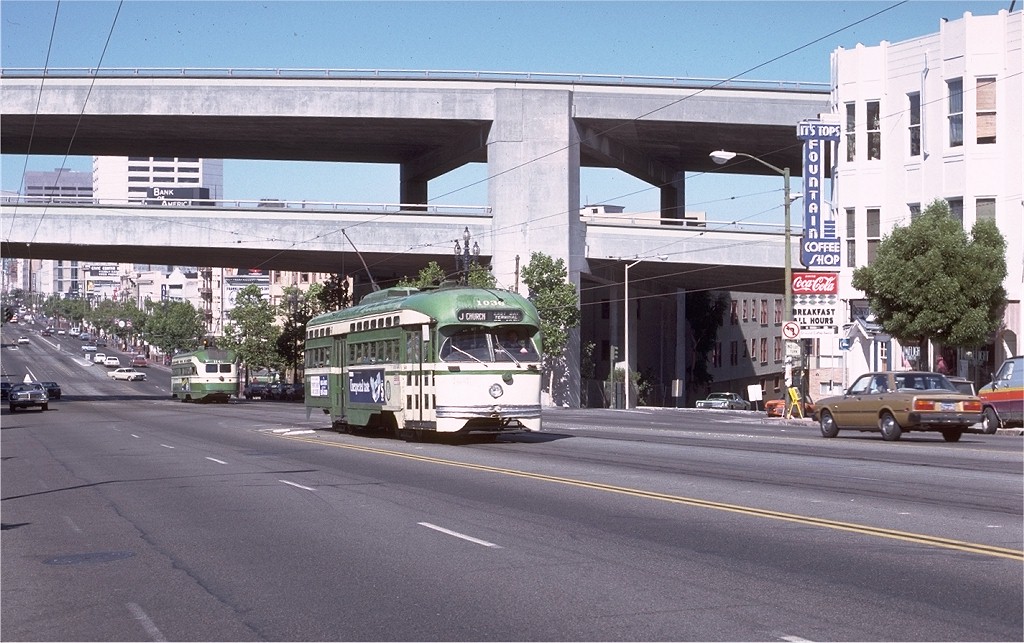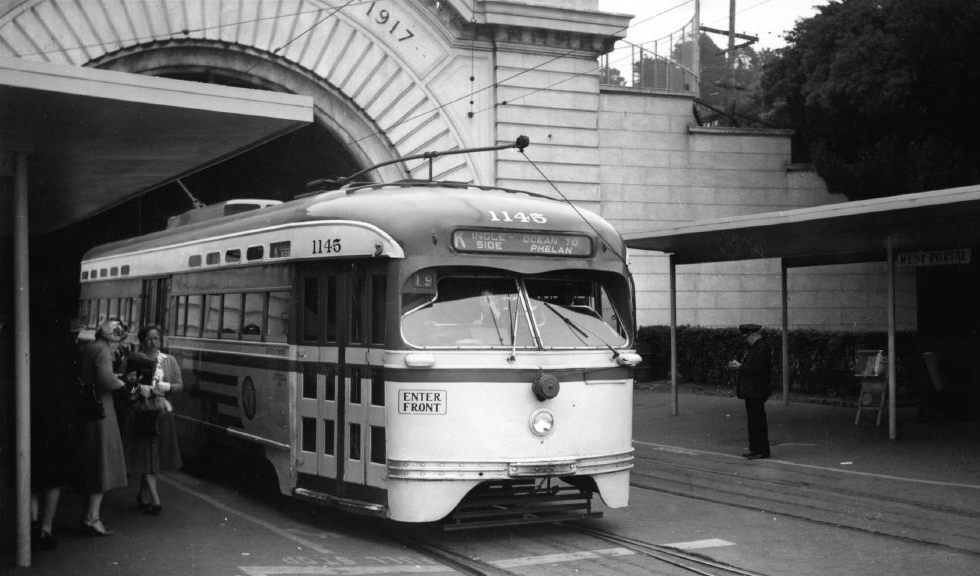We all know that old saying, “They don’t make them like THAT anymore”. With the late Art Curtis, that’s the truth. In his 37-year career with Muni, Art solved all kinds of operational problems as Chief Inspector, but as a “young buck” (his term) operator, he created his share of mischief, too. We’ll be sharing a couple of stories here told by Art himself. This one comes from a 2009 issue of our member magazine, Inside Track. (Join us to get this quarterly magazine with its stories of San Francisco transit history as an exclusive member benefit.)
by Art Curtis

Stand on Market Street today and watch the streetcars go by. You’ll notice they pretty much stay in the same order all day. You might see the Boston PCC, then the yellow Milan tram, then the Harvey Milk car (Muni 1051). Back when I was operating streetcars on Market in the 1960s though, it was a much different story.

They were all streamliner PCCs then, of course, all painted green and cream, so that casual onlookers couldn’t tell if the order of the cars changed. But the order of the cars made a big difference to many of us operators – the difference between a good day and a bad day.
Here’s why. Today, it’s just the F-line on Market, but back then all five streetcar lines, the J, K, L, M, and N, shared those Market Street tracks. Those of us who were “runners” – who liked to take advantage of the PCCs fast acceleration and rapid braking to keep to our schedule – did our best to be sure we had room to run.
Let me give you an example. I once worked a run [a day’s worth of trips] named 27-K, which meant it was run number 27 primarily routed on the K-Ingleside line. I picked up the car from its previous operator every day at 4:47 p.m. at the West Portal of the old Twin Peaks Tunnel. Usually, though, the operator was six to eight minutes late. As a runner that just heightened my enjoyment of the day’s work.

You see, that run was scheduled to start its next trip, from the old Phelan Loop at City College, at 5:06 p.m., less than 20 minutes after I was scheduled to get the car at West Portal. It was a daily, but totally rewarding challenge to get the heavy load of students at that hour on board at the terminal and make it back to West Portal within the bare ten minutes allowed by the schedule (laughably short compared to today’s schedules).

Achieving that reward was especially important during one particular sign-up, because if I got to West Portal late, my follower on the L-line would cut me out, get ahead of me through the tunnel and down Market. That motorman was the infamously slow Joe Shook, who was already a couple of minutes late when he reached West Portal. I would often make a “Hollywood Stop” at West Portal & Ulloa, rolling through the inbound point-on switch ringing my gong and waving at Joe to stop and let me go ahead of him.
If I got in place ahead of Joe, I still had to hot foot it through the Twin Peaks Tunnel and down to Church Street on Market to make sure I got in place ahead of my J-line follower, “Shaky Jake” Grabstein, who always liked to run a couple of minutes ahead of schedule. The final challenge on this first trip on 27-K was to get up the hill to Duboce and make sure I got in place ahead of my “N” follower, whose name I can’t remember – but I do remember that just like the other two, he was so, so slow!! If I could get ahead of them, I could make up any lost time. Nothing better for a runner like me to start down the hill from Duboce and see my leader somewhere down around Fourth or Third Street. Then I could really move!! It made no difference if we had a “swinging load” of passengers or not – just as long as we could move!

But if any of these guys got in front of me, I knew that when I finally got back to West Portal outbound, I’d be really late. That would force the inspector, Bill Veach (whom I had “helped” at West Portal as a young railfan before I was hired), to set up a car trade for me. I usually inherited a “good” car (which to me meant either a double-ended “Torpedo” or a “Baby Ten,” not an ex-St. Louis 1100) when I began my run. But if I was late on the first return trip from East Bay Terminal, I’d be stuck for the rest of the night with whatever car Bill could get another motorman to trade at West Portal. Though he did always try to get me a Baby Ten or a Torpedo if he could, it all depended on which motormen were willing to make the car trades and pull-in late. If he couldn’t make a trade, I told him to just let me run and I’ll get back on time!

This may sound trivial to some readers today, but let me tell you, having a good car to run, and room to run it, made all the difference between a frustrating day at work and a satisfying one – and of course it made things better for passengers, too, since I knew how to keep my car on schedule if no one got in front of me to slow me down!!

Art Curtis’ family has generously asked that donations in his memory can be made to Market Street Railway. If you’re so inclined, click here, and put Art’s name in the honoree box near the bottom of the donation page. We’ll use those donations for something special to honor him.